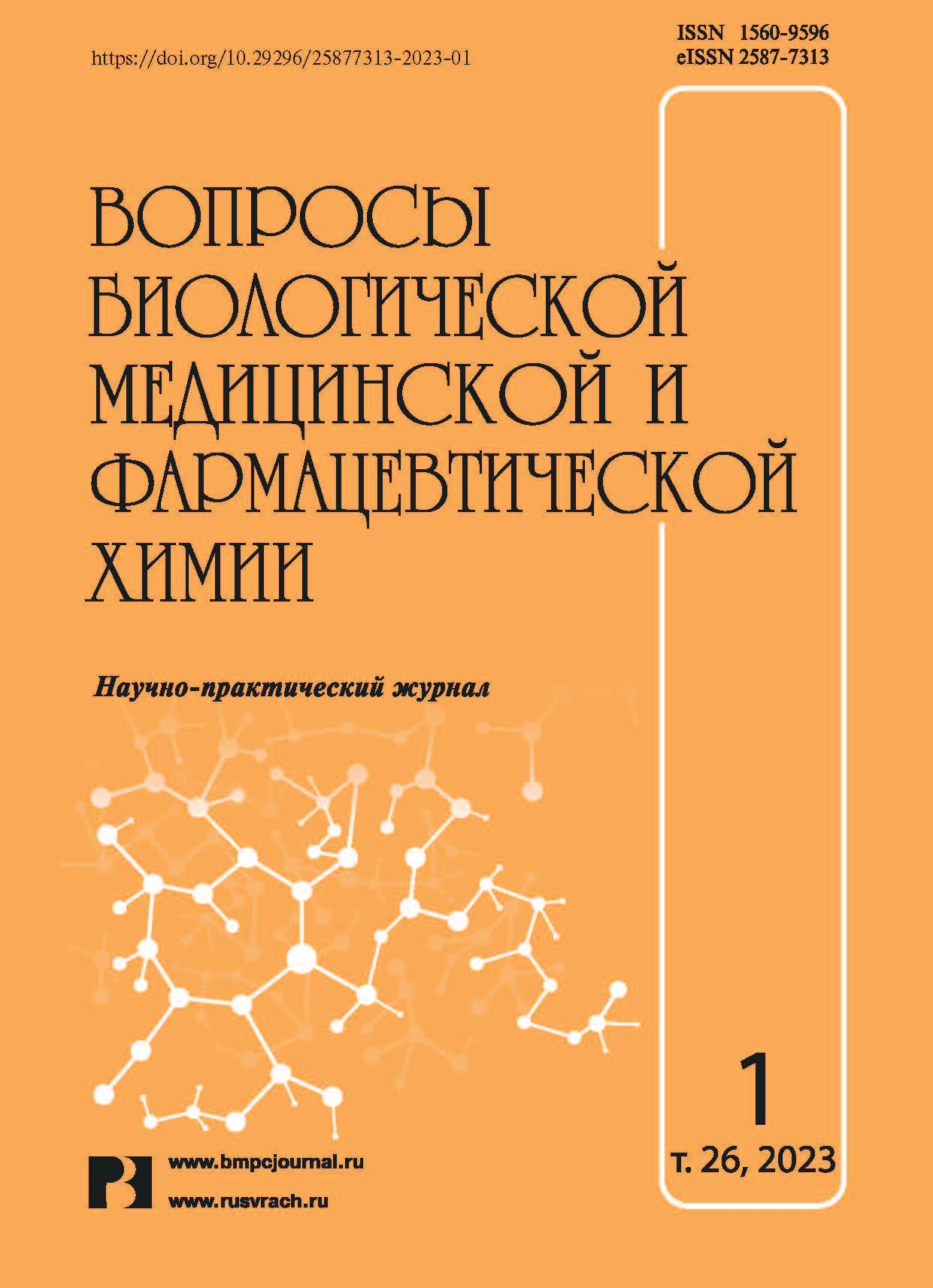Изучение особенностей накопления флавоноидов травой полыни горькой синантропной флоры Ростовской области
- Авторы: Селиванова Ю.А.1, Дьякова Н.А.1, Сливкин А.И.1, Вервикина А.А.1
-
Учреждения:
- Воронежский государственный университет
- Выпуск: Том 26, № 1 (2023)
- Страницы: 8-13
- Раздел: Фармацевтическая химия
- URL: https://journals.eco-vector.com/1560-9596/article/view/532732
- DOI: https://doi.org/10.29296/25877313-2023-01-02
- ID: 532732
Цитировать
Полный текст
Аннотация
Антропогенное воздействие на лекарственные растения является важным фактором, влияющим на синтез вторичных метаболитов. При увеличении антропогенной нагрузки усиливается дополнительный синтез вторичных метаболитов, прежде всего флавоноидов, которые играют важную и очевидную роль в защите растений от стресса.
Цель исследования – изучение особенностей накопления флавоноидов в траве полыни горькой синантропной флоры Ростовской области, а также степени влияния антропогенного воздействия на накопление биологически активных веществ.
Материал и методы. Исследованы образцы лекарственного растительного сырья травы полыни горькой, собранной в Морозовском районе Ростовской области. Сбор и сушку травы полыни горькой проводили в период начала цветения растения (конец июня – начало июля 2021 года). Содержание суммы флавоноидов в пересчете на рутин в отобранных образцах травы полыни горькой определяли троекратно по стандартной фармакопейной методике на спектрофотометре СФ-2000.
Результаты. Изучение растительного сырья, заготовленного в придорожной зоне нескоростной автомобильной дороги (IV категории) с неоживленным движением, а также железной дороги показало наличие прямой зависимости по снижению содержания флавоноидов при увеличении расстояния от транспортных магистралей.
Выводы. Умеренное антропогенное воздействие, которое характеризуется выбросом в окружающую среду различных экотоксикантов, может индуцировать биосинтез флавоноловых соединений. Однако в условиях комплексного токсического стресса (вблизи автомагистрали IA категории с высокой транспортной проходимостью) возможно угнетение антиоксидантной системы растений, выражающееся подавлением выработки полифенолов.
Ключевые слова
Полный текст
Об авторах
Ю. А. Селиванова
Воронежский государственный университет
Автор, ответственный за переписку.
Email: u.a.selivanova@yandex.ru
ассистент, кафедра фармацевтической химии и фармацевтической технологии
Россия, г. ВоронежН. А. Дьякова
Воронежский государственный университет
Email: Ninochka_V89@mail.ru
к.б.н., доцент, кафедра фармацевтической химии и фармацевтической технологии
Россия, г. ВоронежА. И. Сливкин
Воронежский государственный университет
Email: slivkin@pharm.vsu.ru
д.фарм.н., профессор, зав. кафедрой фармацевтической химии и фармацевтической технологии
Россия, г. ВоронежА. А. Вервикина
Воронежский государственный университет
Email: alisa.vervikina@yandex.ru
студентка, фармацевтический факультет
Россия, г. ВоронежСписок литературы
- Дьякова Н.А., Гапонов С.П., Сливкин А.И., Бобина Е.А., Шишорина Л.А., Великанова Л.А. Изучение особенностей накопления флавоноидов травой полыни горькой, произрастающей в различных урбо- и агробиоценозах Воронежской области. Вопросы биологической, медицинской и фармацевтической химии. 2020; 7: 15–21.
- Dyakova N.A., Slivkin A.I., Gaponov S.P., Myndra A.A., Samylina I.A. Analysis of the relationship between the accumulation of pollutants and principal groups of biologically active substances in medicinal plant raw materials using knotweed (Polygonum aviculare L.) and broadleaf plantain (Plantago major L.) leaves as examples. Pharmaceutical Chemistry Journal. 2015; 49: 384–387.
- Бузук Г.Н., Эльяшевич Е.Г. Фармакогностическая характеристика полыни горькой Artemisia absinthium L. Вестник фармации. 2009; 4: 87–97.
- Куркин В.А. Фармакогнозия. Самара: Офорт, 2004: 406–410.
- Киселёва Т.Л., Фролова Ж.А. Морфолого-анатомическое изучение свежесобранного сырья Artemisia absinthium L. – полыни горькой, применяемой в гомеопатии. Традиционная медицина. 2009; 1: 20–24.
- Winkel-Shirley B. Biosynthesis of flavonoids and effect of stress. Current Opinion in Plant Biology. 2002; 5: 218–223.
- Баяндина И.И., Загурская Ю.В. Взаимосвязь вторичного метаболизма и химических элементов в лекарственных растениях. Сибирский медицинский журнал. 2014; 8: 107–111.
- Бокий Г.В. Лекарственная флора г. Ростова-на-Дону. Достижения науки и образования. 2017; 7: 5–6.
- Иванченко, А.М., Хаванский А.Д. Динамика антропогенной нагрузки Ростовской области. Московский экономический журнал. 2021; 7: 261–271.
- Государственная фармакопея Российской Федерации. Издание XIV. Том 4. М.: ФЭМБ, 2018: 6343–6350.
- Ferdinando M.D., Brunetti C., Fini A., Tattini M. Flavonoids as Antioxidants in Plants Under Abiotic Stresses. Abiotic stress responses in plants: metabolism, productivity and sustainability. NY: Springer New York, 2012: 159–179.
- Feild T.C., Lee D.W., Holbrook N.M. Why leaves turn red in autumn. The role of anthocyanins in senescing leaves of redosier dogwood. Plant Physiol. 2001; 127: 566–574.
- Абдрахимова Й.Р., Валиева А.И. Вторичные метаболиты растений: физиологические и биохимические аспекты (Часть 3. Фенольные соединения). Учебно-методическое пособие. Казань: Казанский университет, 2012: 40 с.
Дополнительные файлы








